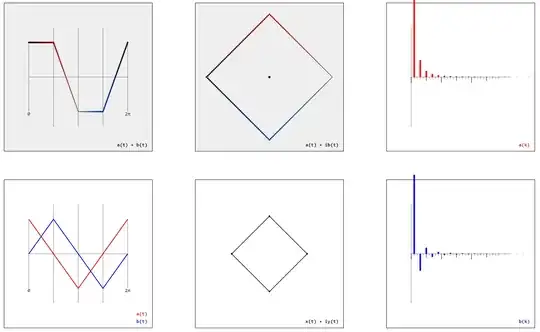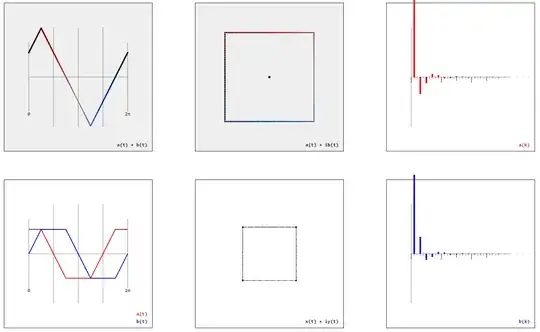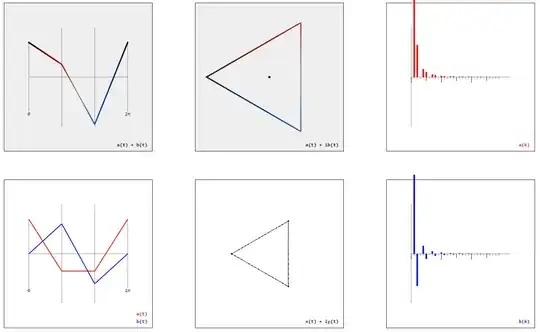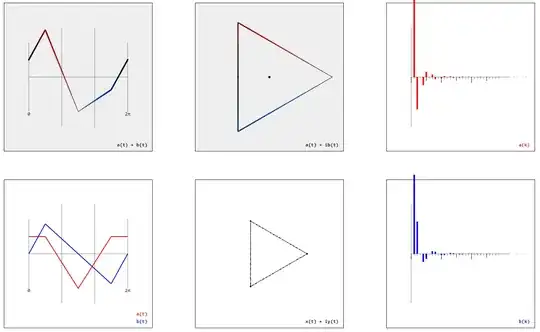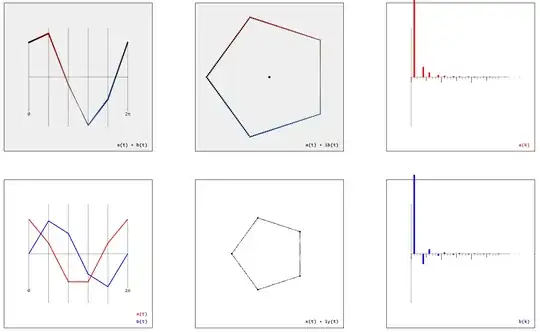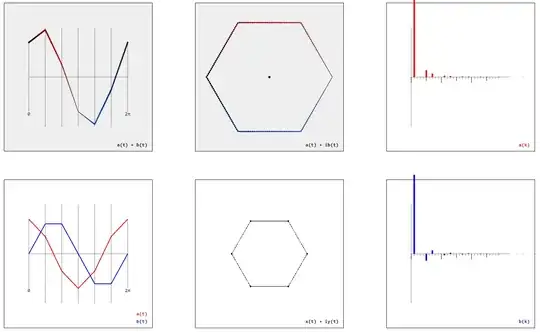The definition of a regular polygon by two real-valued functions $(x(t)$, $y(t))$ – or alternatively by a complex-valued function $x(t) + iy(t)$ – suggests to calculate the Fourier series $a_k$, $b_k$ by
$$a_k \sim \int_0^{2\pi}(x(t)+y(t))\cos(kt)\mathrm{d}t$$
$$b_k \sim \int_0^{2\pi}(x(t)+y(t))\sin(kt)\mathrm{d}t$$
Not surprisingly the two functions
$$a(t) \sim \sum_{k=0}^\infty a_k\cos(kt)$$
$$b(t) \sim \sum_{k=0}^\infty b_k\sin(kt)$$
are linearized approximations of the cosine and sine function (very much like the regular polygons are linearized approximations of the circle):
Rotating the $n$-gon by $\frac{\pi}{n}$ yields another figure with another Fourier series and with another linearized approximation of the cosine and sine function:
For the rotated square, I already know an explicit formula for $a_k$ - thanks to user J.M.'s comment on another question:
$$a^{(4)}_k(\pi/4) \sim \begin{cases} +k^{-2} & \text{ for } k \equiv 1 \mod 8 \text{ or } k \equiv 7 \mod 8\\ -k^{-2} & \text{ for } k \equiv 3 \mod 8 \text{ or } k \equiv 5 \mod 8\\ 0 & \text{ otherwise } \end{cases}$$
and I guess it's a rather straight forward exercise to generalize this for arbitrary $n$-gons. Nevertheless I didn't manage to find a concise closed formula for $a^{(n)}_k(\alpha)$, $\alpha = 0,\pi/n$.
Question 1: Can someone give a closed formula for $a^{(n)}_k(\alpha)$, $\alpha = 0,\pi/n$?
(I assume this formula will only contain $k^{-2}$ terms. So it's more about the period length, positions of the zeros, and the alternation of the signs. Note that the smallest $k>1$ with $a^{(n)}_k, b^{(n)}_k \neq 0$ is just $k = n-1$, see the gallery below.)
Three other questions I have:
Question 2: How does $a^{(n)}_k(\alpha)$ look like for arbitrary rotation angles – not just $\alpha = \pi/n$?
Question 3: Does it make sense to ask for something like a "convolution" $c^{(n)}_k(\alpha)$ that takes the series $a^{(n)}_k(0)$ to the series $a^{(n)}_k(\alpha)$ by
$$a^{(n)}_k(\alpha) = \sum_{m=0}^\infty a^{(n)}_m(0)c^{(n)}_{k-m}(\alpha)$$
If so: What would $c^{(n)}_k(\alpha)$ look like?
Question 4: Is the exponent $2$ in $k^{-2}$ just a coincidence or is it by deeper reasons the dimension of the plane?
